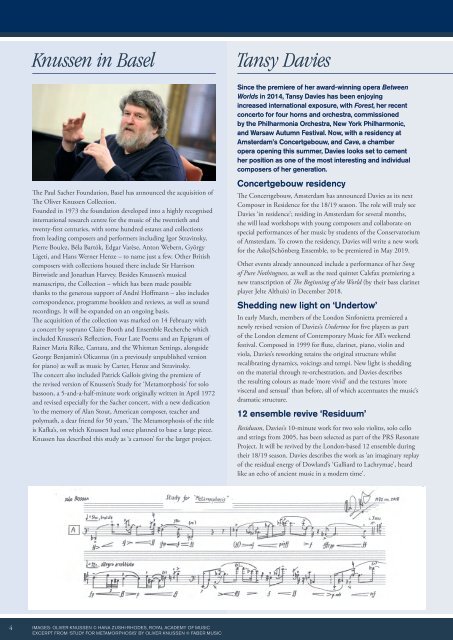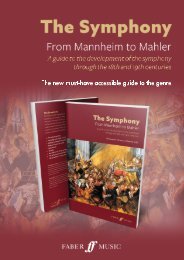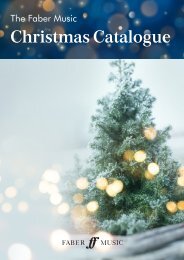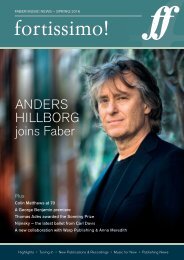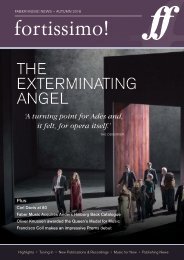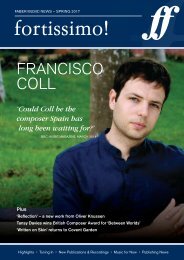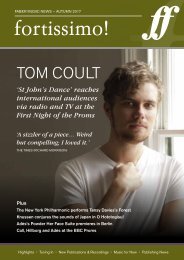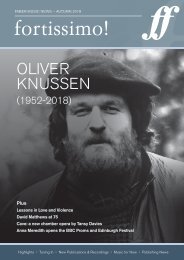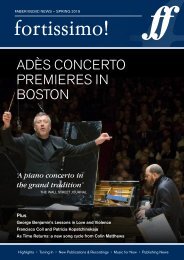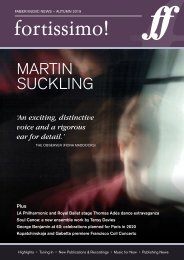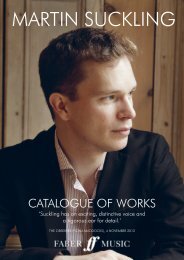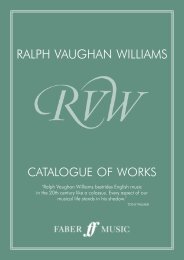Fortissimo Spring 2018
The Spring 2018 edition of the Faber Music newsletter: fortissimo!
The Spring 2018 edition of the Faber Music newsletter: fortissimo!
Create successful ePaper yourself
Turn your PDF publications into a flip-book with our unique Google optimized e-Paper software.
Knussen in Basel<br />
Tansy Davies<br />
The Paul Sacher Foundation, Basel has announced the acquisition of<br />
The Oliver Knussen Collection.<br />
Founded in 1973 the foundation developed into a highly recognised<br />
international research centre for the music of the twentieth and<br />
twenty-first centuries, with some hundred estates and collections<br />
from leading composers and performers including Igor Stravinsky,<br />
Pierre Boulez, Béla Bartók, Edgar Varèse, Anton Webern, György<br />
Ligeti, and Hans Werner Henze – to name just a few. Other British<br />
composers with collections housed there include Sir Harrison<br />
Birtwistle and Jonathan Harvey. Besides Knussen’s musical<br />
manuscripts, the Collection – which has been made possible<br />
thanks to the generous support of André Hoffmann – also includes<br />
correspondence, programme booklets and reviews, as well as sound<br />
recordings. It will be expanded on an ongoing basis.<br />
The acquisition of the collection was marked on 14 February with<br />
a concert by soprano Claire Booth and Ensemble Recherche which<br />
included Knussen’s Reflection, Four Late Poems and an Epigram of<br />
Rainer Maria Rilke, Cantata, and the Whitman Settings, alongside<br />
George Benjamin’s Olicantus (in a previously unpublished version<br />
for piano) as well as music by Carter, Henze and Stravinsky.<br />
The concert also included Patrick Gallois giving the premiere of<br />
the revised version of Knussen’s Study for ‘Metamorphosis’ for solo<br />
bassoon, a 5-and-a-half-minute work originally written in April 1972<br />
and revised especially for the Sacher concert, with a new dedication<br />
‘to the memory of Alan Stout, American composer, teacher and<br />
polymath, a dear friend for 50 years.’ The Metamorphosis of the title<br />
is Kafka’s, on which Knussen had once planned to base a large piece.<br />
Knussen has described this study as ‘a cartoon’ for the larger project.<br />
Since the premiere of her award-winning opera Between<br />
Worlds in 2014, Tansy Davies has been enjoying<br />
increased international exposure, with Forest, her recent<br />
concerto for four horns and orchestra, commissioned<br />
by the Philharmonia Orchestra, New York Philharmonic,<br />
and Warsaw Autumn Festival. Now, with a residency at<br />
Amsterdam’s Concertgebouw, and Cave, a chamber<br />
opera opening this summer, Davies looks set to cement<br />
her position as one of the most interesting and individual<br />
composers of her generation.<br />
Concertgebouw residency<br />
The Concertgebouw, Amsterdam has announced Davies as its next<br />
Composer in Residence for the 18/19 season. The role will truly see<br />
Davies ‘in residence’; residing in Amsterdam for several months,<br />
she will lead workshops with young composers and collaborate on<br />
special performances of her music by students of the Conservatorium<br />
of Amsterdam. To crown the residency, Davies will write a new work<br />
for the Asko|Schönberg Ensemble, to be premiered in May 2019.<br />
Other events already announced include a performance of her Song<br />
of Pure Nothingness, as well as the reed quintet Calefax premiering a<br />
new transcription of The Beginning of the World (by their bass clarinet<br />
player Jelte Althuis) in December <strong>2018</strong>.<br />
Shedding new light on ‘Undertow’<br />
In early March, members of the London Sinfonietta premiered a<br />
newly revised version of Davies’s Undertow for five players as part<br />
of the London element of Contemporary Music for All’s weekend<br />
festival. Composed in 1999 for flute, clarinet, piano, violin and<br />
viola, Davies’s reworking retains the original structure whilst<br />
recalibrating dynamics, voicings and tempi. New light is shedding<br />
on the material through re-orchestration, and Davies describes<br />
the resulting colours as made ‘more vivid’ and the textures ‘more<br />
visceral and sensual’ than before, all of which accentuates the music’s<br />
dramatic structure.<br />
12 ensemble revive ‘Residuum’<br />
Residuum, Davies’s 10-minute work for two solo violins, solo cello<br />
and strings from 2005, has been selected as part of the PRS Resonate<br />
Project. It will be revived by the London-based 12 ensemble during<br />
their 18/19 season. Davies describes the work as ‘an imaginary replay<br />
of the residual energy of Dowland’s ‘Galliard to Lachrymae’, heard<br />
like an echo of ancient music in a modern time’.<br />
4<br />
IMAGES: OLIVER KNUSSEN © HANA ZUSHI-RHODES, ROYAL ACADEMY OF MUSIC<br />
EXCERPT FROM ‘STUDY FOR METAMORPHOSIS’ BY OLIVER KNUSSEN © FABER MUSIC


